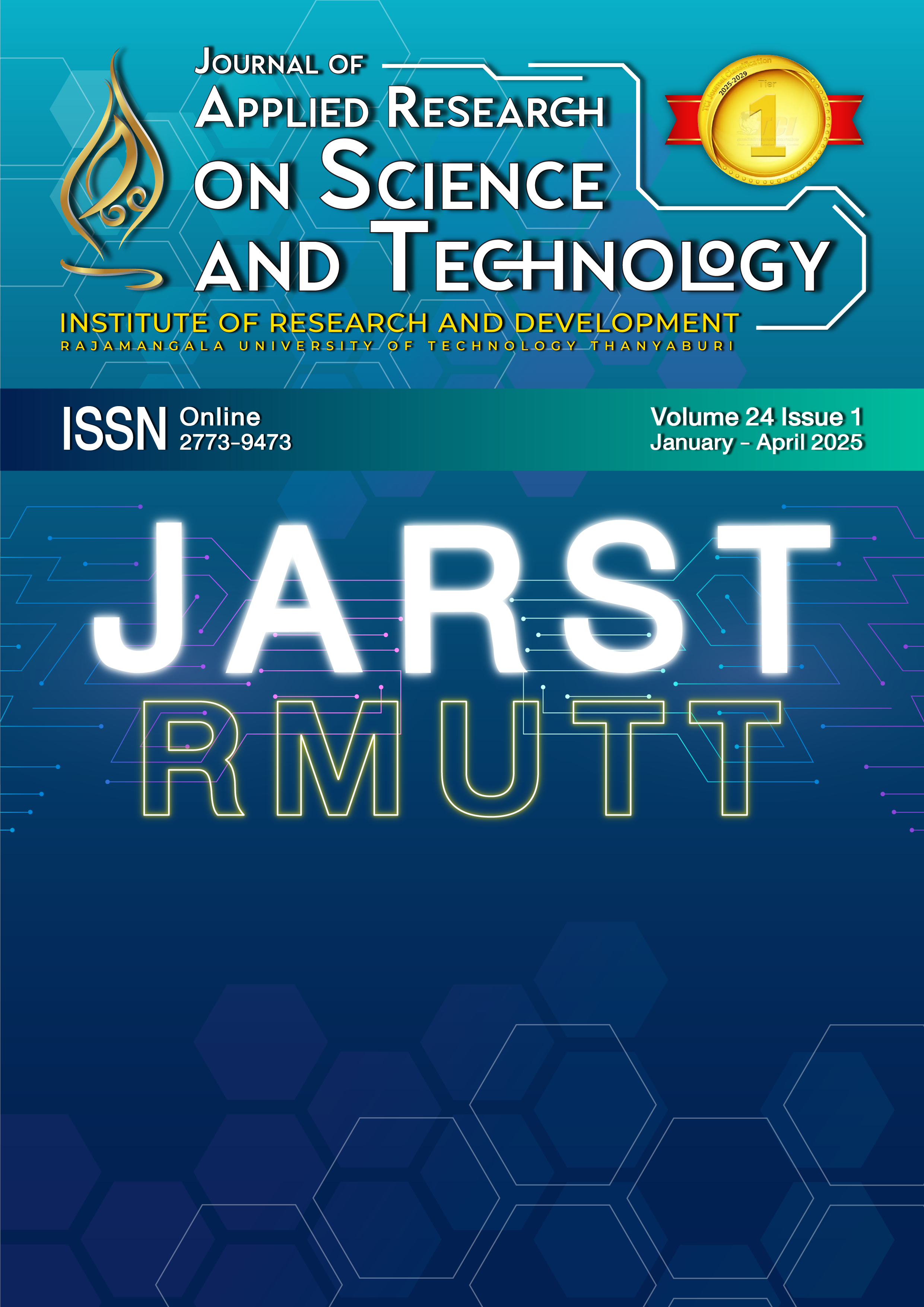Effects of drilling parameters on drill bit wear of ASTM A36 steel
Main Article Content
Abstract
Drilling is a crucial process in metal manufacturing, with drill bits being key tools for creating holes in workpieces. During drilling, wear of the drill bits occurs inevitably. Several factors affect the wear of drill bits, such as materials, workpieces, and drilling parameters. The impact of these parameters on wear is investigated to understand the effects of drilling parameters on drill bit wear. This study used a diameter of 6 mm of uncoated high-speed steel drill bits to create the hole with 30 mm depth on ASTM A36 steel. The drilling was performed utilizing the DMG Mori DMU-50 5-axis drilling machine at three different levels of spindle speed (800, 1100, and 1400 rev/min) and feed rate (120, 135, and 150 mm/min). The sensor force dynamometer measured the thrust force and the cutting torque during drilling. However, many types of wear occur on drill bits during drilling. This research investigates only flank wear on the cutting edge of drill bits. The flank wear on the drill bits was measured with the overlap image technique using an Olympus SZ61 stereo microscope with a C-P3 OPTIKA digital camera. The results showed that adjusting drill parameters to increase the feed per revolution may result in a higher drill bit flank wear rate. Additionally, to quantify the wear of the drill bit based on the number of holes drilled, both the feed per revolution and the cutting distance per hole must be considered.
Article Details

This work is licensed under a Creative Commons Attribution-NonCommercial-NoDerivatives 4.0 International License.
References
Sandvik Coromant. Drilling formulas and definitions [Internet]. US - Mebane, NC: Sandvik Coromant; Available from: https://www.sandvik.coromant.com/en-us/knowledge/machining-formulas-definitions/drilling-formulas-definitions.
Mohammed T, Hayajneh M. Prediction of cutting tool life in drilling reinforced aluminum alloy composite using a fuzzy method. Int J Mater Metallurgical Eng. 2016;10(4):431-7.
ISO (International Organization for Standardization). Tool-life testing with single-point turning tools (ISO 3685). 2nd ed. Geneva: ISO; 1993.
Sultana AZ, Sharif S, Kurniawan D. Effect of machining parameters on tool wear and hole quality of AISI 316L stainless steel in conventional drilling. In: 2nd International Materials, Industrial, and Manufacturing Engineering Conference, MIMEC2015; 2015 Feb 4-6; Bali, Indonesia: Elsevier B.V; 2015. p. 202-7.
Kivak T, Habali K, Seker U. The effect of cutting parameters on the hole quality and tool wear during the drilling of Inconel 718. G U J Sci. 2012;25(2):533-40.
Harahap MR, Nasution AH, Napid S. The effect of cutting speed on the wear and tear of Dormer A100 Brazil drill bit applied to gray cast iron. Int J Res Rev. 2022;9(12):586-91.
Balaji M, Venkata Rao K, Mohan Rao N, Murthy BSN. Optimization of drilling parameters for drilling of Ti-6Al-4V based on surface roughness, flank wear and drill vibration. Meas. 2018;114: 382-9.
Mydin NMBM, Dahnel ANB, Raof NA, MK NK, Mokhtar S. The effect of cutting parameters on tool wear in drilling aluminium 7075. Mattingley Publishing Co Inc. 2022;83:1274-80.
Mohan Kumar A, Parameshwaran R, Rajasekar R, Harissh Ragavendra VC, Praveenraj N. Effect of thrust force, torque, and induced temperature on Kevlar reinforced composites during drilling process. Mater Today Proc. 2021;45:522-8. Available from: https://doi.org/10.1016/j.matpr.2020.02.162.
Ficici F. Investigation of thrust force in drilling polyphthalamide (PPA) composites. Meas. 2021;182.
Zakeri Mehrabad V, Pourmostaghimi V. Tool wear modeling in drilling process of AISI1020 and AISI8620 using genetic programming. Adv Des Manuf Technol. 2017;10(1):93-100.


